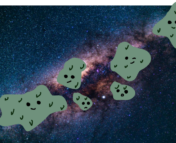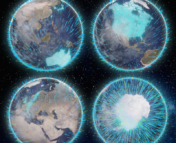Title: Search for 10–1,000 GeV neutrinos from Gamma Ray Bursts with IceCube
Authors: IceCube Collaboration
First Author’s Institution: School of Physics and Center for Relativistic Astrophysics, Georgia Institute of Technology, Atlanta, GA 30332, USA
Status: Available on ArXiv
Particle accelerators, but in space!
Gamma-ray bursts (GRBs) are some of the most powerful explosions in the universe, releasing a “fireball” of particle-filled plasma in a powerful jet that accelerates these particles through the universe. GRBs are understood to originate either from compact object (neutron star or stellar mass black hole) mergers (these are called short GRBs and last less than two seconds!) or from core-collapse supernovae (these are called long GRBs but are just defined as anything longer than two seconds!). GRBs are the most powerful particle accelerators in the universe and are really useful for looking for new particles and/or new particle interactions!
Today’s authors look at GRBs as a possible source of the ghost particle, a.k.a. the neutrino. Neutrinos rarely interact with other matter, which makes them really hard to detect – like a ghost! The IceCube neutrino observatory sees neutrinos all over the sky but can’t figure out where they’re coming from. Since GRBs could produce neutrinos in their outbursts, the authors search through all of IceCube’s data to see if there are any bursts of high energy neutrinos that came in at the same time as a GRB.
How many GRBs does it take to find a neutrino?
Today’s authors search the times surrounding the 2298 GRBs that happened during IceCube-DeepCore’s (IceCube’s highest energy neutrino detector) lifetime for coincident neutrinos. They do this both by looking at each time window individually, and by combining many time windows together to add faint signals that might not be seen in individual windows, but together might show an association between neutrinos and GRBs.
In the first search, the authors define search windows before and after the burst to look for neutrinos (see Figure 1). Since neutrinos don’t interact very often, they can easily stream out of dusty environments that photons struggle to escape from, meaning that they could actually be expected before gamma-ray (and other photon) emission. They search the entire sky for neutrinos in these windows and assess the probability that there is an excess of neutrinos coming from the source location compared to the neutrino background that we see all over the sky.
The second search looks at groups of GRBs that are associated in location and time with neutrino events and look at the combined probability of GRB/neutrino association of all the events in this group. This makes it possible to correlate GRBs with neutrinos even if they don’t individually stand out. Unfortunately, this method doesn’t find any groups of neutrinos that are any more statistically significant than individual neutrinos that fall within GRB time windows.
Trials factors and tribulations
The winning GRB of the first search (i.e., the most significant neutrino-GRB correlation) is GRB bn 140807500 – since there are a lot of GRBs recorded by burst hunting instruments like Fermi-GBM and Swift BAT it’s too much of a hassle to give them individual names and rather they get “telephone numbers” corresponding to the date they were detected. The corresponding neutrino falls within 100s of GRB bn 140807500 and has a p-value of 4.6 x 10-5, which is the probability that the correlation between the GRB and neutrino is just a lucky coincidence and not from actual correlation (i.e., small p-values mean a more likely detection of neutrino GRBs!).
This probability seems really small, and at first glance it seems like the neutrino and GRB are most likely connected here! Unfortunately this doesn’t take into account trials factors (also called the look elsewhere effect), which quantify the statistical statement that if you look at enough GRBs and neutrinos, there will be some that line up with each other in space and time, just by chance. To account for this, the authors must correct for 2268 trials, one for each GRB. After correcting for trials, this leaves us with a much larger p-value of 0.097, meaning there’s a one in ten chance that the GRB and neutrino aren’t really connected. Generally particle (and astroparticle) physicists require a p-value of 3×10-7 (about 1 in 3.5 million, corresponding to the [in]famous 5 sigma threshold!) to feel confident in saying that these events are actually correlated.
Don’t forget about the BOAT
In October 2022, the brightest of all time (BOAT) GRB was detected (at the same time this paper was being prepared!) so the authors didn’t include it directly in their dataset, but made some predictions as to how it would measure up to the other GRBs that were considered. The BOAT was so bright that the authors calculated the expected neutrino signal to be 6-8 times the combined expected signal of all 2268 GRBs used in this paper’s study (see Figure 2)! This is because the BOAT is so much more energetic in gamma-rays than other GRBs, implying a large flux of high energy neutrinos, which are localized to more precise regions in the sky than for the lower energy neutrinos expected to accompany other GRBs. This means that we can more confidently associate any observed neutrinos with the location of the GRB.
There’s still work to be done to see if there are any neutrino events that seem to come from the BOAT GRB, but this leaves the idea open that neutrinos could come from GRBs (or at least that we can more confidently say that they don’t)! The universe sometimes throws surprises like the BOAT at us, which allows astronomers to study the high energy universe a lot more easily. Luckily, we’ve entered into the era of time domain astronomy where instruments like Fermi-GBM and Swift BAT allow us to catch more bursts and explosions than ever before, giving us an increasingly large sample of GRBs to study!
Astrobite edited by Cole Meldorf
Featured image credit: NASA




